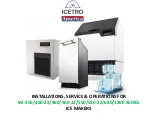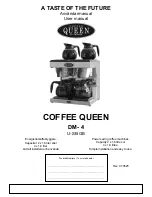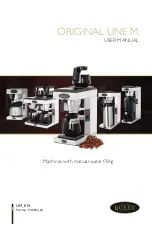
13
- water tank (A7);
- coffee spouts (A11);
- cappuccino maker (A18) (“16. Cleaning”);
- pre-ground coffee funnel (A4);
- infuser (A9), accessible after opening the infuser door (A8);
- control panel (B).
Important!
• Do not use solvents, abrasive detergents or alcohol to clean
the coffee machine. With De’Longhi superautomatic coffee
machines, no chemical products are required for cleaning
purposes.
• None of the components of the appliance can be washed
in a dishwasher with the exception of the drip tray grille*
(A15).
• Do not use metal objects to remove encrustations or coffee
deposits as they could scratch metal or plastic surfaces.
16.2 Cleaning the internal circuit
If the appliance is not used for more than 3/4 days, before using
it again, we strongly recommend switching it on and:
- 2/3 rinse cycles by pressing
(B5);
- delivering hot water for a few seconds (section “15. Deliv-
ering hot water”).
Please note:
After cleaning, it is normal for the grounds container (A13) to
contain water.
16.3 Cleaning the coffee grounds container
When the light (flashes, the coffee grounds container (A13)
must be emptied and cleaned. The appliance cannot be used to
make coffee until you have cleaned the grounds container. Even
if not full, the empty grounds container message is displayed 72
hours after the first coffee has been prepared. For the 72 hours
to be calculated correctly, the machine must never be turned off
with the main switch (A6).
Important! Danger of scalding
If you make a number of cappuccinos one after the other, the
metal cup tray (A17) becomes hot. Wait for it to cool down be-
fore touching it and handle it from the front only.
To clean (with the machine on):
• Remove the drip tray (A14) (fig. 23), empty and clean.
• Empty the grounds container (A13) and clean thoroughly
to remove all residues left on the bottom.
• Check the red condensate tray (A12) (fig. 23) and empty
if necessary.
16.4 Cleaning the drip tray and condensate tray
Important!
The drip tray (A14) is fitted with a level indicator (A16) (red)
showing the amount of water it contains (fig. 24). Before the
indicator protrudes from the cup tray (A17), the drip tray must
be emptied and cleaned otherwise the water may overflow the
edge and damage the appliance, the surface it rests on or the
surrounding area.
To remove the drip tray:
1. Remove the drip tray and grounds container (A13) (fig. 23);
2. Remove the cup tray (A17) and drip tray grille* (A15), then
empty the drip tray and grounds container and wash all
components;
3. Check the red condensate tray (A12) and empty if
necessary;
4. Replace the drip tray complete with grille* and grounds
container.
Important!
When removing the drip tray, the grounds container must be
emptied, even if it contains few grounds.
If this is not done, when you make the next coffees, the grounds
container will fill up more than expected and clog the machine.
16.5 Cleaning the inside of the machine
Danger of electric shock!
Before cleaning internal parts, the machine must be turned off
(see section “5. Turning the appliance off”) and unplugged from
the mains power supply. Never immerse the machine in water.
1. Check regularly (about once a week) that the inside of the
appliance (accessible after removing the drip tray (A14)) is
not dirty. If necessary, remove coffee deposits with a brush
and a sponge;
2. Remove all the residues with a vacuum cleaner (fig. 25).
16.6 Cleaning the water tank
1. Clean the water tank (A7) regularly (about once a month)
and whenever you replace the water softener filter (C4) (if
provided) with a damp cloth and a little mild washing up
liquid;
2. Remove the filter (C4) (if present) and rinse with running
water;
3. Replace the filter (if installed), fill the tank with fresh water
and replace;
4. (Models with water softener filter only) Deliver about
100ml of water.
16.7 Cleaning the coffee spouts
1. Clean the coffee spouts (A11) regularly with a sponge or
cloth (fig. 26A);































